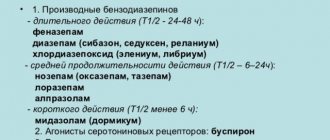Publications in the media
(Coffeinum-natrii benzoas)
Synonyms.
Composition and release form. Powder, tablets of 0.075, 0.1 and 0.2 g; 10% and 20% solutions in ampoules of 1 and 2 ml and in syringe tubes of 1 ml.
Indications. Increased mental and physical performance; infectious and other diseases accompanied by inhibition of the functions of the central nervous system and cardiovascular system; poisoning with narcotic and other drugs that depress the central nervous system; drowsiness; hypotension; enuresis; migraine.
Pharmachologic effect. Caffeine sodium benzoate is a psychostimulant - a purine derivative. The neurochemical mechanism of action of drugs in this group is their ability to compete with adenosine for “purine” or adenosine receptors, which contributes to the development of a psychostimulating effect. Sodium caffeine benzoate in large doses inhibits phosphodiesterase, which leads to the accumulation of intracellular c-AMP, which enhances glycogenolysis, metabolic processes in muscle tissue and the central nervous system. The drug stimulates all parts of the central nervous system. Compared to amphetamine stimulants, the effect on the central nervous system is more “mild”. Sodium caffeine benzoate has a positive inotropic and chronotropic effect, causing an increase in the frequency and strength of heart contractions, and increases cardiac output.
In high doses, caffeine causes severe tachycardia, and in highly sensitive patients arrhythmias (ventricular extrasystoles) may develop. The action of caffeine has central and peripheral components regarding vascular tone. By stimulating the vasomotor center, caffeine increases vascular tone, and with a direct effect on smooth muscles, it reduces vascular tone. Caffeine increases systemic vascular resistance, which leads to increased blood pressure. These effects are associated with the drug's blockade of adenosine vasodilation and activation of the sympathetic division of the autonomic nervous system. The drug has a stimulating effect on skeletal muscles, possibly by inducing the release of acetylcholine, increasing the strength of contractions and relieving muscle fatigue. Caffeine sodium benzoate stimulates the secretion of hydrochloric acid by parietal marks and the activation of pepsin. The drug has a mild diuretic effect by increasing renal blood flow and glomerular filtration rate and reducing the reabsorption of sodium and water in the proximal renal tubules. Inhibits uterine contractility, increases the concentration of catecholamines in the blood plasma and urine, causes a short-term increase in plasma levels due to stimulation of glycogenolysis and lipolysis. The drug stimulates the respiratory center, increasing the breathing rate. In high doses, caffeine has analeptic properties.
Pharmacokinetics. The drug is easily absorbed from the gastrointestinal tract into the blood when taken orally or parenterally. Absorption of methylxanthines occurs mainly due to their lipophilicity rather than water solubility. Caffeine sodium benzoate is quickly distributed in all tissues of the body; easily penetrates the placental and blood-brain barriers; the volume of distribution in adults ranges from 0.4 to 0.6 l/kg. Binds to plasma proteins by 25-36%. The peak concentration of the drug in the blood plasma is observed 50-75 minutes after oral administration. Therapeutic concentrations in blood plasma are 5-25 mcg/ml (25.8-128.8 μmol/l). The drug is metabolized in the liver. About 80% of its dose is converted to paraxanthine (1,7-dimethylxanthine), about 10% to theobromine (3,7-dimethylxanthine), and about 4% to theophylline (1,3-dimethylxanthine). These compounds are further metabolized by demethylation to first form monomethylxanthines and ultimately methylated uric acid derivatives. T 1/2 averages 3-7 hours. The drug is excreted mainly in the form of metabolites by the kidneys, 1-2% is excreted unchanged.
Side effects. Dizziness; cardiopalmus; irritability, nervousness or severe nervous agitation; tremor; sleep disturbance; diarrhea, nausea, vomiting.
Contraindications. Increased excitability, insomnia; severe hypertension and atherosclerosis, organic diseases of the cardiovascular system; glaucoma.
Adverse reactions when interacting with other drugs. When taken concomitantly in large doses with MAO inhibitors, including procarbazine and selegiline, caffeine sodium benzoate may cause the development of dangerous cardiac arrhythmias or severe hypertension as a result of increased sympathomimetic effects of caffeine; small doses of caffeine-sodium benzoate may lead to a slight increase in blood pressure and tachycardia. With simultaneous use of the drug with other central nervous system stimulants, the development of hyperstimulation of the central nervous system, up to the development of arrhythmias and seizures, is possible. Concomitant use of barbiturates (phenobarbital) and caffeine sodium benzoate may increase caffeine metabolism due to barbiturate-induced induction of liver microsomal enzymes, leading to increased elimination of caffeine sodium benzoate. Cimetidine and OK reduce the metabolism of caffeine in the liver, which leads to an increase in its concentration in the blood and increased side effects of the latter.
Information for the patient. The drug is used orally in tablets of 0.1-0.2 g 2-3 times a day 30-40 minutes before meals. Do not take the drug immediately before bed. Extended-release capsules should be swallowed whole without breaking, crushing or chewing. It is not recommended to drink caffeine sodium benzoate with milk, as it is bound by 30% milk protein, and the release of caffeine from this binding is very slow. Smoking accelerates the metabolism of caffeine-sodium benzoate and reduces its therapeutic effects. Drinking large quantities of coffee with a high caffeine content in the drink (60 mg of caffeine per 100 g of drink), tea (50 mg per 100 g of drink), cola, cocoa and chocolate with preparations containing caffeine or caffeine-sodium benzoate may lead to tachycardia , increased breathing and dizziness. Closely monitor for signs indicating the occurrence of possible side effects, especially such as stimulation of the central nervous system and irritation of the gastrointestinal mucosa, dysfunction of the cardiovascular system.
Missed dose: Take the missed dose as soon as possible; do not take it at all if there is no time left before the next dose; do not take double doses.
Formula
Chemical formula C8H10N4O2.
Chemical name 1,3,7-Trimethylxanthine (and as sodium benzoate).
Characteristics of the substance: an alkaloid found in tea leaves and coffee seeds.
Appearance: white needle-shaped crystals or white crystalline powder, has a bitter taste, no odor. Caffeine is difficult to dissolve in alcohol, but easily dissolves in boiling water. Dissolves slowly in cold water.
Overdose
A safe dose of caffeine for the body is no more than 400 mg per day. Do not overuse the aromatic drink. Overdose can lead to various pathologies. In case of poisoning, the central nervous system, cardiovascular system and gastrointestinal tract are affected.
Signs of overdose:
- Headache
- State of anxiety
- Increased sensitivity
- Tachycardia
- Increased blood pressure
- Trembling limbs
- Nausea, vomiting
- Stomach pain
- Muscle spasms
- Confusion
- Breathing disorders
In acute poisoning, loss of orientation and epilepsy occurs, which is accompanied by seizures and convulsions. When the first symptoms of intoxication appear, it is important to begin cleansing the body as soon as possible and call an ambulance.
First aid for poisoning
Severe poisoning should be treated under medical supervision. First aid provided in a timely manner will help save the victim. It is necessary to ensure a flow of fresh air and remove tight clothing from the patient.
How to remove caffeine from your body at home:
- Carry out gastric lavage with regular boiled water (chilled)
- Take adsorbents (Smecta, activated carbon)
- Drink plenty of fluids; use of rehydration agents is permissible
If the above steps do not help, you should rush to call for medical help.
Consequences of use
Long-term intoxication leads to pronounced, but reversible, dysfunction of internal organs. Possible side effects of caffeine consumption:
- development of tolerance
- addiction formation
- withdrawal syndrome
- insomnia
- nightmares
- impaired appetite
- irrational weight loss
- fussiness
- tendency to conflicts, anxious and aggressive behavior
- recurrent states of asthenic confusion
- convulsive twitching of the calf muscles
- trembling of tongue, lips, fingers
- interruptions in heart function
- torpid, stagnant thinking
- men sometimes experience decreased libido, rarely erectile dysfunction
- decreased bone density
Just a few years ago, caffeine was prohibited for all cardiac patients. However, recent work has shown the effectiveness of low doses of the substance in improving cardiovascular prognosis in the absence of contraindications. Moderate use of the stimulant probably reduces the risk of malignant diseases of the colon and liver.
Contents in green and black tea
Caffeine in tea is present along with tannin. When brewing a drink, the substance is not released entirely, so the drink has a gentler effect on the body. Tannin prevents the psychostimulant from being quickly absorbed and promotes its rapid elimination.
Black tea contains approximately 70 mg of alkaloid per 200 ml. Green tea contains more psychostimulants, containing approximately 85 mg per cup.
One cup of jasmine green tea contains 60-70 mg of caffeine.
The amount of alkaloid in tea depends on:
- From the type of tea
- Growing conditions
- From flavoring additives
Caffeine in energy drinks
People often drink energy drinks to stay alert for a long time.
An ordinary energy drink contains approximately 80 mg of a psychostimulant, and this, as is known, is only 1/5 of the permissible norm. However, it is worth noting that energy drinks contain other components besides caffeine, so you do not need to drink 5 cans a day.
But there are sports energy drinks that contain 215 mg of psychostimulant. Thanks to this drink, people can stay alert for 5 hours.
Addiction
Caffeine addiction occurs in people who consume more than 400 mg of caffeine (4 cups of natural coffee) daily. You can overcome coffee addiction on your own with a certain amount of willpower.
What factors contribute to the development of addiction:
- Not getting enough sleep
- Artificial lighting
- Tobacco smoking
- Working at the computer
Signs of addiction:
- Irritation if you can’t drink a drink when you want
- Thoughts about coffee lift your spirits
- Headache goes away after a cup of invigorating drink
- Unreasonable anxiety and fears
- Confusion of consciousness if a new “portion” is not consumed in a timely manner
Addiction can lead to health problems. However, it is necessary to give up your favorite drink gradually to avoid withdrawal symptoms.
Coffee is good for you, but consuming it in excess is dangerous to your health.
Substance abuse
The effects of caffeine determine a person's psychological need for daily intake.
Chronic intoxication is the main reason for the formation of substance abuse. In severe cases, it resembles amphetamine addiction, but, fortunately, it occurs much more easily without life-threatening consequences. As the period of abuse increases, household stimulants no longer provide such a euphoric effect. Most addicts develop tolerance; daily doses of the substance can reach 500-1000 mg. For the development of substance abuse, the patient’s personality traits play an important role.
Stopping stimulants leads to withdrawal symptoms. During withdrawal (“withdrawal”), signs of nervous exhaustion come to the fore: unbearable fatigue, apathy, irritability. Often the mood decreases to the point of depression. Using the substance slightly alleviates the painful condition, which confirms the fact of addiction.


